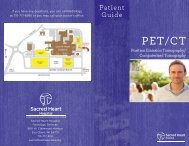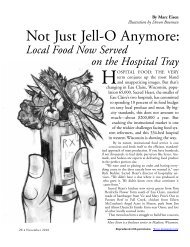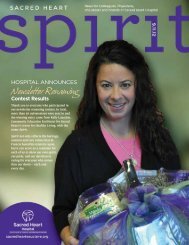Breast Biopsy - Sacred Heart Hospital
Breast Biopsy - Sacred Heart Hospital
Breast Biopsy - Sacred Heart Hospital
Create successful ePaper yourself
Turn your PDF publications into a flip-book with our unique Google optimized e-Paper software.
If you have any questions, you can call Radiology<br />
at 715-717-6985 or you may call your doctor’s office.<br />
Patient<br />
Guide<br />
<strong>Breast</strong> <strong>Biopsy</strong><br />
<strong>Sacred</strong> <strong>Heart</strong> <strong>Hospital</strong><br />
Radiology Services<br />
900 W. Clairemont Avenue<br />
Eau Claire, WI 54701<br />
715-717-4151<br />
sacredhearteauclaire.org
<strong>Breast</strong> <strong>Biopsy</strong><br />
A breast biopsy is a way to take out small amounts of breast<br />
tissue using a special needle. The tissue will then be tested for<br />
cancer. There are three ways to find the right area in the breast<br />
for the biopsy: mammograms taken from different views<br />
(stereotactic mammography), ultrasound, and MRI.<br />
Before the Procedure<br />
You will be asked some questions about your health background<br />
and the medicines you take. It is very important to let your doctor<br />
or nurse know if you take any medicines that slow down the clotting<br />
ability of the blood, such as Coumadin, Plavix, aspirin, or medicines<br />
with aspirin in them. These medicines may need to be stopped 5-7<br />
days before the procedure, but only as directed by your doctor.<br />
You can eat and drink as usual the day of the procedure. Take your<br />
normal medicines except those that have been stopped by your<br />
doctor.<br />
When you arrive, you will have some blood taken to check for clotting<br />
problems. The procedure will be explained to you. You can ask<br />
any questions you have about the biopsy, its risks, or how it will be<br />
done. Once your questions have been answered, you will be asked to<br />
sign a consent form. You will be offered medicine for your comfort.<br />
During the Procedure<br />
With stereotactic mammography and MRI, you will lie on your<br />
stomach on a special table. Your breast will go through a hole in<br />
the table. The person doing the procedure (radiologist) will do the<br />
biopsy from below the table. Your breast will be compressed just<br />
like during a mammogram to find the area to be biopsied. When it<br />
is found, pictures from different views will be taken to help the<br />
radiologist put the needle in the right place for the biopsy.<br />
With ultrasound, you will lay on your side or back depending on the<br />
area of breast to be biopsied.<br />
The skin on your breast will then be cleaned and the radiologist<br />
will numb your breast before putting in the needle. Once the needle<br />
is in place, pictures are again taken to make sure it is in the right<br />
place. The radiologist will then take tissue samples from your breast.<br />
The needle will stay in your breast while the samples are being<br />
taken. You will hear a click sound with each sample that is taken.<br />
The radiologist may take 4-12 samples depending on the area to<br />
be biopsied.<br />
After the samples are taken and before the needle is taken out,<br />
the radiologist may put a small marker in your breast. This will<br />
show where you had the biopsy on future x-rays. This marker is<br />
very small and you will not be able to feel it once it is placed in<br />
your breast.<br />
The needle is then removed and the nurse or technologist will<br />
hold direct pressure for 10 minutes to the biopsy site to stop any<br />
bleeding. When the bleeding has stopped a small bandage will be<br />
applied.<br />
The biopsy takes about 1 ½ hours. You can get results of your<br />
biopsy from your doctor in 2-3 days.<br />
After the Procedure<br />
Your nurse will go over home care instructions with you before<br />
you leave the hospital. If you took medicine to help you relax, you<br />
will need a driver to take you home. You will have soreness and<br />
bruising from the needle that can last a few days. To help take away<br />
any pain, you may take acetaminophen (Tylenol), or apply an ice<br />
pack to your breast for a few minutes. You should have a follow-up<br />
mammogram in six months.
















